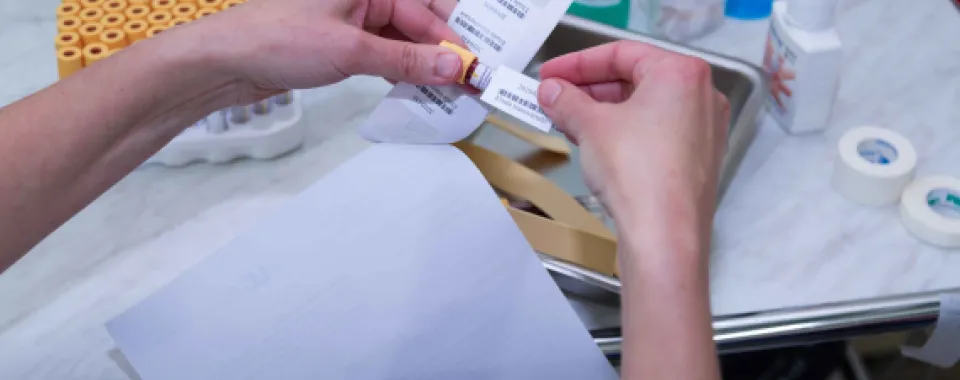
A study carried out among 2'766 people by the University Hospitals of Geneva (HUG), the Geneva Centre for Emerging Viral Diseases, and the University of Geneva (UNIGE), Switzerland, reveals that, at the time of the decline of the Coronavirus pandemic, only 10.8% of the Geneva population had been infected with Covid-19. Moreover, compared to adults between 20 and 50 years of age, children between 5 and 9 years of age are three times less likely to be infected and those over 65 years of age half as likely. These results were published in The Lancet.
Over the five weeks of the study - from 6 April to 9 May – the overall seroprevalence increased from about 5% to about 11% of the population. Taking into account the time for antibodies to be produced after symptoms (with a median of 10.4 days), the researchers estimated that for every confirmed case, there were approximately 12 actual infections in the community.
These results suggest that only a minority of the Geneva population has been infected during this pandemic wave, despite the high rate of COVID-19 cases identified during the acute phase of infection (1% of the population in less than 2 months).
Children and elderly less affected
Young children (5-9 years) and the elderly appear to have a much lower seroprevalence than other age groups. Indeed, only 1 in 123 children in this age group tested positive. However, further studies will be needed to better understand the dynamics of infection and of antibodies in children under 5 years of age, and to determine whether children, in addition to being generally less susceptible to Cov2-SARS, are also less severely affected.
The study also reveals a high concentration of infections within households. For example, despite the low seroprevalence of children, 17.1% of children had at least one household member who tested positive, which may suggest that children are infected by adults. On the other hand, only 3.0% of participants over 65 years of age had a household member that tested positive.
Furthermore, lower seroprevalence estimates among the elderly tend to confirm the effectiveness of partial containment measures. However, their ability to produce antibodies may be reduced due to age-related weakening of the immune system..
Protective measures have certainly contributed to the decline of the pandemic.
The preliminary results of this study provide an important benchmark for assessing the outbreak status. At the time when Switzerland appears to be reaching the end of its first wave of the COVID-19 pandemic, only 1 in 10 people have developed antibodies to SARS CoV-2, despite the fact that Switzerland is one of the most affected countries in Europe. The results of this study - the largest population-based seroprevalence study to date - are consistent with preliminary reports from other teams around the world.
These results therefore underline that the decline of the epidemic may have taken place despite the fact that the vast majority of the population is not immune, which implies that other factors are at play.
The value of seroprevalence studies
Seroprevalence surveys based on the detection of specific immunoglobulin type G (IgG) are used to measure the proportion of the population that has ever been exposed to coronavirus. However, they do not provide any indication of full or partial immunity to coronavirus or of the duration of such immunity.
Seroprevalence surveys are nevertheless crucial for estimating the dynamics of the epidemic and for preparing the appropriate public health response. They are also more accurate than studies based on nasopharyngeal smears and RT-PCR tests, which are largely dependent on screening policies and miss people with mild or no symptoms, or who do not come for testing.
This general population seroprevalence study is ongoing and will be refined to take into account symptomatology and socio-demographic factors.
2'766 participants
The study was conducted among a representative sample of the Geneva population drawn from the participants of the Bus Santé study, an annual survey that examines the health of the population of the Canton of Geneva. From 6 April to 9 May 2020, sampled people were invited, together with their family members, for a blood test and a questionnaire. This sample consisted of 52.6% women and 47.2% men, and included 4.4% children between 5 and 9 years of age and 13.3% people over 65 years of age. A total of 2,766 people from 1,339 households took part.
The study was carried out by a team from the HUG and UNIGE under the direction of Professor Idris Guessous, Head of the HUG Primary Care Division and professor at the Department of Community Health and Medicine of the Faculty of Medicine, of Dr. Silvia Stringhini, epidemiologist in charge of the Population Epidemiology Unit at the HUG and Privat-Docent at the Faculty of Medicine, and of Professor Antoine Flahault, Director of the Institute of Global Health of the Faculty of Medicine. The study received support from Professor Laurent Kaiser’s Virology Laboratory and from the Geneva Centre for Emerging Viral Diseases, and was funded by the Swiss Federal Office of Public Health, the Swiss School of Public Health (Corona Immunitas programme), the Pictet Group’s Charity Foundation, the Fondation Ancrage, the Fondation Privée des HUG and the Geneva Centre for Emerging Viral Diseases.
HUG Media Contact
presse-hug@hug.ch
+41 22 372 37 37